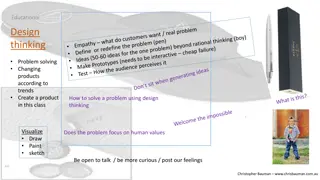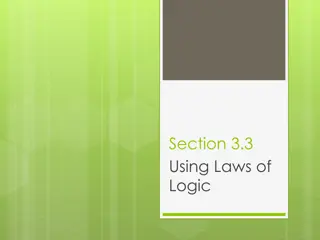Unlocking Creativity and Innovation: Lateral Thinking vs Logical Thinking
Embrace the power of lateral thinking to challenge assumptions, generate new possibilities, and break free from traditional logic. Discover how logical thinking and lateral thinking differ in their approach to problem-solving, and learn how to leverage both methods to spur creativity and innovation. Dive into the world of brainstorming, free association, and questioning assumptions to widen the space of solution possibilities. Explore practical exercises to put theory into action and unleash your team’s creative potential.
Download Presentation

Please find below an Image/Link to download the presentation.
The content on the website is provided AS IS for your information and personal use only. It may not be sold, licensed, or shared on other websites without obtaining consent from the author.If you encounter any issues during the download, it is possible that the publisher has removed the file from their server.
You are allowed to download the files provided on this website for personal or commercial use, subject to the condition that they are used lawfully. All files are the property of their respective owners.
The content on the website is provided AS IS for your information and personal use only. It may not be sold, licensed, or shared on other websites without obtaining consent from the author.
E N D
Presentation Transcript
Breaking Assumptions Pablo G. Tello EU Office/IdeaSquare CERN P. G. Tello
yes, but how? P. G. Tello
The most difficult to achieve is to Challenge Assumptions Generate new possibilities P. G. Tello
A useful technique LATERAL THINKING is a method of thinking concerned with changing concepts and perception. It is about discovering what is not immediately obvious, and about ideas that may not be obtainable by using only traditional step-by-step logic. Dr. Edward deBono P. G. Tello
Logical thinking is primarily concerned with judging the true value of statements and seeking errors. It is very helpful when we implement solutions. But there comes a time when one cannot proceed further without restructuring the pattern ? without breaking up the old pattern which has been so useful and arranging the old information in a new way. P. G. Tello
Breaking up the old pattern and generating a new possibility P. G. Tello
Lateral vs Logical thinking Logical search Lateral search One is looking for the BEST POSSIBLE approach. One is trying to produce as MANY ALTERNATIVES as possible. One stops when one comes to a promising approach. One acknowledges the promising approach and may return to it later but goes on to generating others. One alternatives. considers only reasonable Alternatives do not have to be reasonable. Purpose: search for the best one. Purpose: To loosen up rigid patterns and provoke new patterns. P. G. Tello
Logical vs lateral thinking One Answer Brainstorming, free association, questioning assumptions Wide space of solution possibilities Begin with one problem Logical thinking process Begin with one problem, data and assumptions P. G. Tello
Enough theory let s go for the practice (each exercise 7 min and 1 to explain solution) ( work in teams and select a presenter) P. G. Tello
Exercise 1 How would you divide a square into four equal pieces? P. G. Tello
Solution 1 Did you consider any of these? P. G. Tello
Exercise 2 Problem: A landscape gardener is given instructions to plant four special trees so that each one is exactly the same distance from each of the others. P. G. Tello
Solution 2 One tree is planted on top of a hill. (the broken assumption is that they are all planted on a leveled piece of ground). P. G. Tello
Exercise 3 IX Add a single line to turn this into a six; generate as many solutions as you can. P. G. Tello
Solution 3 Generated possibilities by broken assumptions SIX 6 can be written in different ways Lines are also curve IX6 P. G. Tello
Exercise 4 What do you read in the figure above? P. G. Tello
Solution 4 Flip/Flop Broken assumption: o can be an i (figure/background) P. G. Tello
Exercise 5 There are six glasses in a row. The first three are full of water, and the next three are empty. By moving only one glass how can you make them alternate between full and empty? P. G. Tello
Solution 5 Pour the water from the 2nd glass into the 5th glass. P. G. Tello
Exercise 6 We are in the 50 s so no mobiles exist yet. You are driving down the road in your car on a wild, stormy night in a lonely place. You pass by a bus stop and you see three people waiting for the bus: An old lady who is sick and needs to be taken to the hospital. An old friend who once saved your life. The perfect partner you have been dreaming about. Hint: You can make everyone happy including yourself Knowing that there can only be one passenger in your car, whom would you choose? P. G. Tello
Solution 6 The old lady of course! After helping the old lady into the car, you can give your keys to your friend, and wait with your perfect partner for the bus. P. G. Tello
Exercise 7 Move the minimum number of sticks to make this operation right. I + IX = X P. G. Tello
Solution 7 Flip it upside down and you have it moving zero sticks I + IX = X I + IX = X P. G. Tello
Exercise 8 Move just two coins to form two lines, each containing six coins. P. G. Tello
Solution 8 P. G. Tello
Exercise 9 Suppose you want to start restaurant and have difficulties to come up with ideas. You then decide to list three assumptions and reverse them. Reverse Assumption a) Restaurants have menus either written, verbal or implied. a ) Restaurants have no menus of any kind. b ) Restaurants give food away for free. b) Restaurants charge money for food. c ) Restaurants do not serve food of any kind. c) Restaurants serve food. Come up with an idea for each one of the reversals P. G. Tello
Solution 9 Reverse Idea a ) The chief informs the client of what he bough that day. Asks the customers what ingredients appeal to them and cooks an exclusive dish. Recipe will be sent to them by email. a ) Restaurants have no menus of any kind. b ) Restaurants give food away for free. b ) An outdoor caf where customers pay for time instead of food. Use a time stamp to charge by the minute. Selected food or beverages are sold for free. c ) Restaurants do not serve food of any kind. c ) Create a restaurant with a unique d cor in an exotic environment and rent out the location. People bring their own food and beverages and pay a service charge for the location. P. G. Tello
Messages to take home Lateral thinking is a useful technique to actually learn how to think out of the box. It is complementary to our more familiar logical and critical thinking mode. Practise it as much as you can. P. G. Tello
Most important Challenge assumptions and Generate new different solutions P. G. Tello
Exercise Come up with a business idea for the following 3 establishments reversing 3 assumptions about each one of them. based on Prepare a pitch of 3 min about every idea that you have generated. P. G. Tello
Establishment one: Insurance Company Reverses Assumptions Idea/Pitches a) a ) a ) b) b ) b ) c) c ) c ) P. G. Tello
Establishment two: Prison Reverses Assumptions Idea/Pitches a) a ) a ) b) b ) b ) c) c ) c ) P. G. Tello
Establishment three: Pick your own one Reverses Assumptions Idea/Pitches a) a ) a ) b) b ) b ) c) c ) c ) P. G. Tello
To read further Edward de Bono, Lateral Thinking: Creativity Step by Step, (1970), Harper & Row 1973. Michael Michalko, Thinkertoys: A Handbook of Creative-thinking Techniques. 2nd ed. Berkeley, Calif: Ten Speed Press, 2006. P. G. Tello
Thank you Any questions? P. G. Tello























